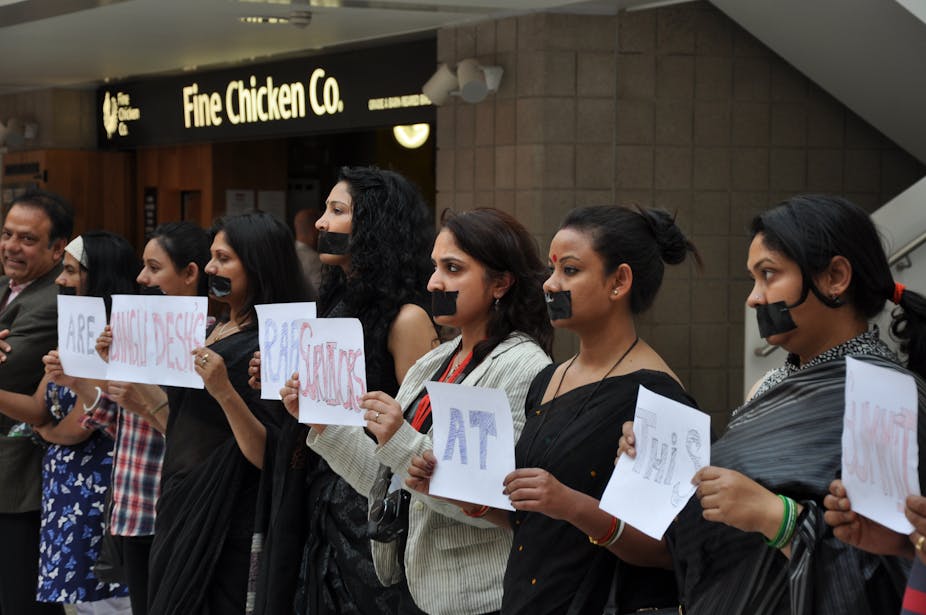“Bangladesh is not a conflict.” This is what I was recently told by the special representative of the UN secretary-general at the summit on End Sexual Violence in Conflict ESVC. She said the history of wartime rape during the Bangladesh war of 1971 could not be included in the summit, which took its starting point as the Bosnia conflict of 1992.
But the Bangladesh war crimes tribunal is ongoing and perpetrators are being convicted for raping women during the Bangladesh war in 1971. Not only that, but there are important lessons to be learned from the history of wartime rape during the Bangladesh war of 1971.
In 1947, the independence of India from British colonial rule resulted in the partition of India by carving out the eastern and north-western corners of the country, which came to be known as East and West Pakistan. With vast differences of culture and language, over the years the West Pakistani government imposed various administrative, linguistic, military, civil and economic controls. This led to the nine-month long liberation war in 1971 leading to the formation of independent Bangladesh. The war left an estimated 3m dead and 200,000 women raped by the Pakistani army and Razakars (local Bengali collaborators).
In an internationally unprecedented move, the Bangladeshi government publicly referred to the women raped as birangonas (war heroines) to prevent them from being ostracised and absorb the large number of raped women into the new nation. Behind the extensive government programmes of rehabilitation lay the suffering of innumerable women and the choices they had been confronted with.
Women had access to abortion (which was again globally unprecedented in 1972) or were encouraged to put their children up for international adoption. In a Muslim country, and in the early 1970s, these were radical precursors to international legislation on abortion in circumstances of forced pregnancy adopted in the 1990s. The government attempted to marry off the “war heroines”, but women who did not want to marry demanded training and jobs which were provided by the government. Women were accepted by their families or lived in women’s hostels, working in various government jobs.
Overall, this post-war transition was not smooth. While some women married caring, understanding men, others encountered the nightmare of being rebuked after marriage. Many others continue to live today with the husbands they had been married to when they were raped by the Pakistani army and Bengali collaborators, while being referred to as “shamed” by some (often due to politico-economic reasons) in their communities. There is no doubt that the impact of the rehabilitation programme had varied effects on the lives of the women raped during the Bangladesh war of 1971. But it was not a homogenous effect of ostracisation of the women raped. Instead, women endured this violent experience in various complex ways.
The government and press fell silent about the birangonas during the military rule of 1975-1990, but the history of rape of 1971 has remained in Bangladeshi public memory over the past 43 years through literary and visual representations. Since the 1990s, there has been a focus by Bangladeshi feminists, filmmakers and human rights activists on the need to document testimonies of war heroines from different class backgrounds. Today, a famous sculptor – Ferdousy Priyobhashini – has become the one of the most high-profile and protagonist birangonas.
On March 25 2009 the Bangladesh government set up a war crime tribunal to try people accused of murder, torture, rape and arson during 1971 and six individuals have been given death penalties, some on the basis of their role in wartime rape during 1971. In December 2013 one of them, Abdul Kader Mullah, was executed.
In a painful contradiction, one of the British lawyers defending those accused of wartime rape during 1971, Toby Cadman, was present in the fringe mock trial chaired by Cherie Booth QC at the summit. His presence angered many Bangladeshi activists and they organised a protest at the summit by covering their mouths with tape with the message: “Where are Bangladesh’s rape survivors at this summit?”

During the summit, the Libyan representative announced the government in Tripoli was planning a similar campaign to Bangladesh’s, where rape survivors would be encouraged to come forward to shift the discourse of shame from them. There is much to learn about sexual violence in conflict by considering how wartime rape has become a public memory in Bangladesh (unlike the commonly held assumption of complete silence), how the raped women were accorded heroic significance by the government and the varied effects that had on the life trajectory of the women raped and their families.
The Global Summit to End Sexual Violence in Conflict was a missed opportunity. But there is still much to learn about the war heroines of Bangladesh.

